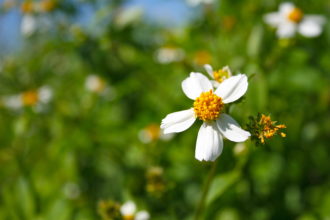TALLAHASSEE, Florida – Cover crops used as refuge crops in vegetable production can control insect pests by fostering populations of natural enemies and competitor non-virus vectoring species, based on the results of USDA-ARS research.
Research entomologists Stephen Hight with the USDA-ARS Insect Behavior and Biocontrol Research Unit in Florida, and Stuart Reitz with Oregon State University, led a Southern Sustainable Agriculture Research & Education-funded project from 2012 to 2014 to study whether bidens and blue lupine can control Western flower thrips and tobacco thrips in tomatoes, peppers, and cucumbers. The study explored more sustainable methods of pest management than insecticide use.
“Our labs have made considerable progress in management programs for thrips in vegetable crops. One key sustainable strategy that we have developed to manage pest thrips is to maintain the biotic resistance of agroecosystems by fostering populations of natural enemies and competitor species of non-pest thrips in the farmscape,” said Hight. “This can be accomplished by maintaining refuge crops for these species adjacent to cash crop fields. A number of these beneficial companion plants are also useful winter and summer cover crops.”
Western flower thrips and tobacco thrips are major crop pests that can transmit the tomato spotted wilt virus, leading to crop failure. In the Research & Education Grant, (LS11-244), “Taking Advantage of Pest Thrips Ecology to Increase Sustainability of Vegetable Crop Production,” the researchers conducted research trials in Florida and Georgia to determine how well non-pest thrips outcompeted the Western flower thrips and tobacco thrips within four cropping systems: plastic mulch, lupine mowed, lupine tilled, and a lupine/bidens mix).
Results were mixed depending on the specific trial year and crop combinations. Generally, the study found more non-vector thrips (species like Frankliniella tritici) on crop bloom samples than the Western flower thrip and the tobacco thrip in all four cropping systems two of the three years studied. Trials in 2013 found that Western flower thrips and tobacco thrips outnumbered non-vectors on cucumbers. Non-vectors outnumbered vectors in tomatoes and peppers that year.
In the 2014 study year, non-vector thrips were in significantly higher numbers than the Western flower thrip and tobacco thrip in the plots with the bidens cover crop than either of the other cropping systems.
“The bidens companion plant attracted non virus-vectoring thrips that often displaced viruliferous thrips species,” said Hight.
When looking at the prevalence of tomato spotted wilt virus, while there was no significant difference in either the tomatoes or cucumbers grown with or without bidens, the pepper plots in the 2012 trial saw a significantly higher incidence of the virus in plots where bidens was not present.
“Results indicate that cover and companion crops could promote sustainability in vegetable farmscapes by enhancing biotic resistance,” said Hight.
In addition to measuring pest pressure, the researchers also analyzed yields. In one study year, they found that yields in the crops with transitional cover crops and bidens were comparable with conventional plastic mulch.
“Under some years and combinations with bidens, the cover crop blue lupine had limited positive effect on yield weights when compared with conventional plastic mulch treatments,” said Hight.
Weeds, however, were a limiting factor. Weed populations in general were very high in other cropping systems than under conventional plastic mulch. The researchers speculate that the since the plastic raises soil temperatures, seed germination and crop growth were faster compared to the crops in the systems that did not use plastic mulch.
“These cover crop/companion crop systems would require changes in current cropping practices, but they can produce comparable crops to those grown with current higher input methods,” said Hight.
--30—
Published by the Southern Region of the Sustainable Agriculture Research and Education (SARE) program. Funded by the USDA National Institute of Food and Agriculture (NIFA), Southern SARE operates under cooperative agreements with the University of Georgia, Fort Valley State University, and the Kerr Center for Sustainable Agriculture to offer competitive grants to advance sustainable agriculture in America's Southern region. This material is based upon work that is supported by the National Institute of Food and Agriculture, U.S. Department of Agriculture, through Southern Sustainable Agriculture Research and Education, under sub-award number: LS11-244. USDA is an equal opportunity employer and service provider. Any opinions, findings, conclusions, or recommendations expressed in this publication are those of the author(s) and do not necessarily reflect the view of the U.S. Department of Agriculture.
